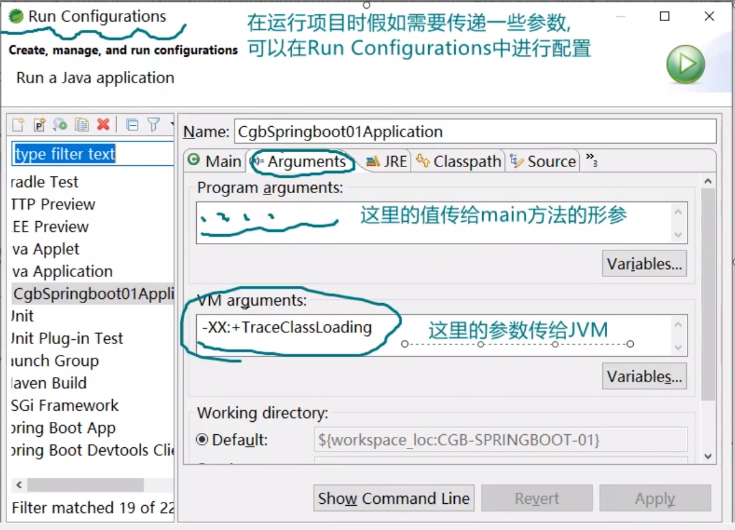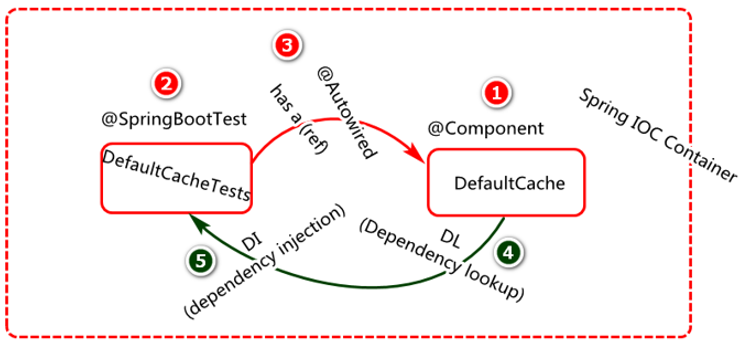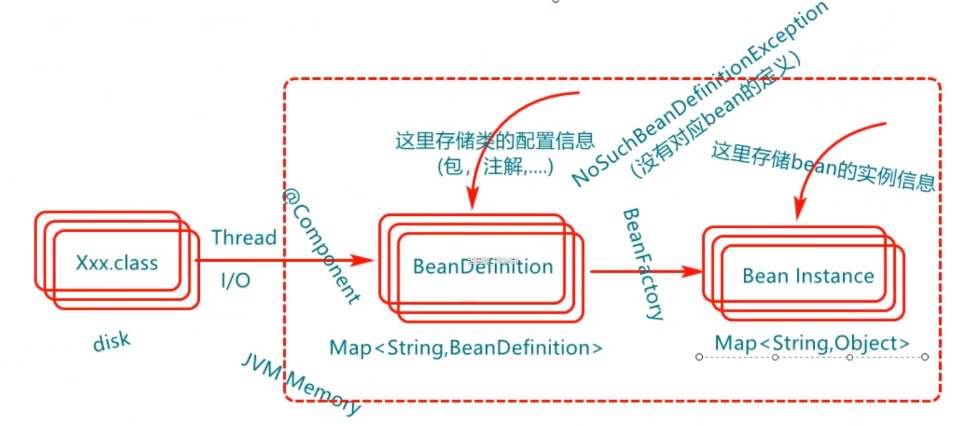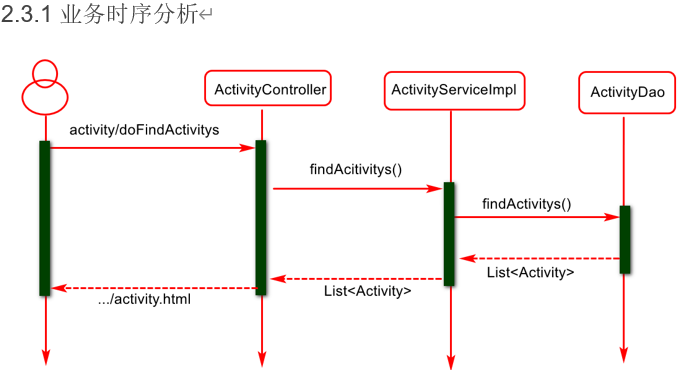java web 46 : SpringBoot


SpringBoot 项目在启动时,首先基于启动入口类上的注解描述,进行自动配置并扫描指定包以及子包中的类进行加载,
然后检测类上是否有Spring框架中指定的注解描述(例如@Component,@Controller,@Service等)。
假如有,则将类交给Spring框架中的BeanFactory工厂接口的实现类对象,此工厂对象会基于反射创建Bean的实例,
假如此Bean指定了生命周期方法,还会调用生命周期方法。
当实例创建以后,Spring框架还会基于类的作用域描述,将实例存储到不同作用域的容器中。以实现Bean对象的科学应用。

图中描述了DefaultCacheTests类与DefaultCache类的关系,这两个类通过指定注解(@SpringBootTest,@Component)进行了描述,
其意图是告诉spring框架这个两个类的实例的创建由Spring负责,并且由Spring框架基于@Autowired注解的描述完成DefaultCacheTests实例中有关DefaultCache类型的值的注入(DI)。

NoSuchBeanDefinitionException的原因
类在项目启动时都会加载,但是否
1.类所在的包是否在启动类所在包或子包
2.类是否使用了spring特定注解
NoUniqueBeanDefinitionException:
实现类对象有多个,spring框架无法选择
package com.company.common.pool; import javax.annotation.PostConstruct; import javax.annotation.PreDestroy; import org.springframework.context.annotation.Lazy; import org.springframework.context.annotation.Scope; import org.springframework.stereotype.Component; /** * @Component * 将此类交给spring管理,spring在何时创建此对象 * @Lazy ---延迟加载 * 此注解的含义为,告诉spring框架,如果暂时用不到,就暂时不要创建此类实例 * 适用于不常使用的大对象,一个对象创建之后长时间不用会消耗资源 * 默认为@Lazy(true) * 只针对singleton作用域的对象 * @Scope("singleton") ---作用域 * 默认是单例作用域"singleton",这个类在实例在一个spring容器中只有一份,但同类型不同名会在容器中存多份,单例是指同类同名 * 适用于频繁使用 * 单例必须考虑线程安全问题 * "prototype",每次从spring容器获取对象都会创建新的实例,但spring容器不负责销毁 * 适用于应用次数少,prototype域的对象不会存入容器池 * @PostConstruct ---对象构建以后执行,用于执行初始化操作 * @PreDestroy ---在单例对象销毁前执行 * spring容器在销毁之前,会先将容器(Bean池)中的对象进行移除, * 如果对象中定义了生命周期销毁方法,此时会先调用生命周期销毁方法(进行一些资源释放操作),再进行移除 * prototype域的对象不会存入池,不会调用@PreDestroy方法 */ @Scope("singleton") @Lazy @Component public class ObjectPool { public ObjectPool() { System.out.println("ObjectPool()"); } @PostConstruct public void init() { // 生命周期初始化 System.out.println("init()"); } @PreDestroy public void close() { // 生命周期销毁前执行 System.out.println("close()"); } }
package com.company.common.pool; import org.junit.jupiter.api.Test; import org.springframework.beans.factory.annotation.Autowired; import org.springframework.boot.test.context.SpringBootTest; @SpringBootTest public class ObjectPoolTests { @Autowired private ObjectPool objectPool01; @Autowired private ObjectPool objectPool02; @Test void testObjectPool() { System.out.println(objectPool01); System.out.println(objectPool02); System.out.println(objectPool01==objectPool02); } }
package com.company.pj.common.service; import org.springframework.beans.factory.annotation.Autowired; import org.springframework.beans.factory.annotation.Qualifier; import org.springframework.stereotype.Component; import com.company.pj.common.cache.Cache;
/**
* @Autowired 由spring框架定义,用于描述类中属性或相关方法(例如构造方法)。
* Spring框架在项目运行时假如发现由他管理的Bean对象中有使用@Autowired注解描述的属性或方法,
* 可以按照指定规则为属性赋值(DI)。其基本规则是:
* 首先要检测容器中是否有与属性或方法参数类型相匹配的对象,假如有并且只有一个则直接注入。
* 其次,假如检测到有多个,还会按照@Autowired描述的属性或方法参数名查找是否有名字匹配的对象,有则直接注入,没有则抛出异常。
* 最后,假如我们有明确要求,必须要注入类型为指定类型,
* 名字为指定名字的对象还可以使用@Qualifier注解对其属性或参数进行描述(此注解必须配合@Autowired注解使用)。
*
* @Qualifier 实现类有多个时,注入属性名字与实现类名不同或实现类名有多个时(无法一对一匹配)
* 可以用此注解指定实现类
*/ /** * @Component 描述类时,用于告诉spring框架,由spring通过反射构建此类型对象 * 执行@Autowired构造方法,此时需要取到Cache对象 * @Autowired 三种写法 */ @Component("searchService") public class SearchService { @Autowired //1. 修饰变量 @Qualifier("weakCache") private Cache cache; @Autowired //2. 修饰有参构造 public SearchService(@Qualifier("softCache") Cache cache) { System.out.println("SearchService有参"); this.cache = cache; } public SearchService() { System.out.println("SearchService无参"); } @Autowired //3. 修饰setter,配合无参构造使用 @Qualifier("softCache") public void setCache(Cache cache) { System.out.println("setter"); this.cache = cache; } public Cache getCache() { return cache; } }





 浙公网安备 33010602011771号
浙公网安备 33010602011771号